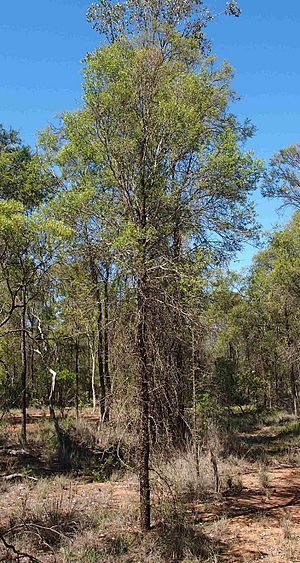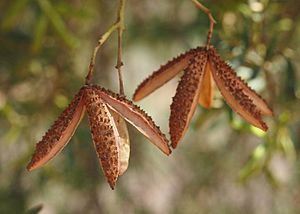Scrub leopardwood facts for kids
Quick facts for kids Broad-leaved leopard tree |
|
|---|---|
 |
|
| Habit near Bauhinia | |
| Scientific classification | |
| Genus: |
Flindersia
|
| Species: |
dissosperma
|
| Synonyms | |
|
|
The Broad-leaved leopard tree (scientific name: Flindersia dissosperma) is a small tree. It is also known as scrub leopardwood. This tree belongs to the Rutaceae family, which includes citrus plants. It grows only in eastern-central Queensland, Australia. This means it is endemic to that area. The tree has leaves that look like feathers. Each leaf has three to five smaller leaflets. These leaflets are shaped like ovals or eggs. The tree also grows white or cream-colored flowers. Its fruit is covered with rough, bumpy points.
Contents
What the Broad-leaved Leopard Tree Looks Like
The Broad-leaved leopard tree can grow up to 10 m (33 ft) tall. Its leaves grow in pairs on the branches. Each leaf can be 15–630 mm (0.59–24.80 in) long. Most leaves are "pinnate," meaning they have smaller leaflets arranged along a central stem. There are usually three to five leaflets on each leaf.
These small leaflets are 6–37 mm (0.24–1.46 in) long and 2–8 mm (0.079–0.315 in) wide. They are shaped like an oval or an egg, with the narrower part at the base. The main stem of the leaf (called the rachis) has a wing-like shape. The leaflets themselves are directly attached to this stem.
Flowers and Fruit
The flowers of the Broad-leaved leopard tree grow in clusters called "panicles." These clusters are 20–90 mm (0.79–3.54 in) long. Some of the flowers are male-only. The small green parts at the base of the flower, called sepals, are about 1–1.5 mm (0.039–0.059 in) long. The actual flower petals are white to cream-colored and measure 3–3.5 mm (0.12–0.14 in) long.
This tree usually blooms from August to October. After flowering, it produces a woody fruit. This fruit is a capsule, about 20–30 mm (0.79–1.18 in) long. Inside the capsule are winged seeds. These seeds are 15–18 mm (0.59–0.71 in) long. The wings help the seeds to spread in the wind.
How the Tree Got Its Name
The scrub leopardwood was first officially described in 1857. A scientist named Ferdinand von Mueller wrote about it. He published his description in a science journal called Hooker's Journal of Botany and Kew Garden Miscellany. He first named the plant Strzeleckya dissosperma.
Later, in 1929, another scientist named Karel Domin changed its name. He renamed it Flindersia dissosperma in his book Bibliotheca Botanica. This is the name we use today.
Where the Tree Lives
The Broad-leaved leopard tree mostly grows in dry scrubland. It often shares its home with other trees like brigalow (Acacia harpophylla) and poplar box (Eucalyptus populnea). You can find this tree in east-central Queensland, Australia. Its range stretches from near Charters Towers down to near Springsure.
Is the Tree Protected?
The Queensland Government has a law called the Nature Conservation Act 1992. Under this law, the Broad-leaved leopard tree (Flindersia dissosperma) is listed as being of "least concern." This means that currently, there are enough of these trees, and they are not considered to be in danger of disappearing.


